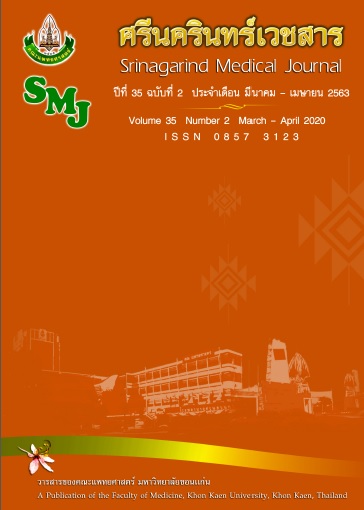The Measurement Radiation Doses to the Lens of Eye and Thyroid Gland from Computed Tomography Brain Scans and Radiation Dose Around in CT Scan Room: Phantom Study
Keywords:
เครื่องซีที, โอเอสแอล, ปริมาณรังสี, พื้นที่ควบคุม, พื้นที่ตรวจตรา, CT scan, OSL dosimeter, radiation dose, controlled area, supervised areaAbstract
การตรวจวัดปริมาณรังสีที่เลนส์ตาและต่อมไทรอยด์จากการตรวจซีทีสมองและปริมาณรังสีรอบภายในห้องซีที: การศึกษาในหุ่นจำลอง
จิรันธนิน เภารอด1, วัฒนา วงศ์ษานนท์1, เพชรากร หาญพานิชย์1, ภัทรพร ดรศีจันทร์1,
ปนัสดา อวิคุณประเสริฐ2,3*, จุฑาทิพย์ ศรีวิชา3, วิทิต ผึ่งกัน4
1 ภาควิชารังสีวิทยา คณะแพทยศาสตร์ มหาวิทยาลัยขอนแก่น จ.ขอนแก่น
2 ภาควิชารังสีวิทยา คณะแพทยศาสตร์วชิรพยาบาล มหาวิทยาลัยนวมินทราธิราช กรุงเทพฯ
3 สาขาวิชาฟิสิกส์ คณะวิทยาศาสตร์ มหาวิทยาลัยขอนแก่น จ.ขอนแก่น
4 กลุ่มมาตรฐานการวัดทางนิวเคลียร์และรังสี สำนักงานปรมาณูเพื่อสันติ กรุงเทพฯ
หลักการและวัตถุประสงค์: เพื่อวัดปริมาณรังสีที่เลนส์ตาและต่อมไทรอยด์จากการตรวจซีทีสมองด้วยเครื่องซีที 3 เครื่อง ร่วมกับการใช้และไม่ใช้บิสมัทป้องกันรังสี และการตรวจวัดปริมาณรังสีกระเจิงรอบห้องซีที
วิธีการศึกษา: ติดอุปกรณ์วัดปริมาณรังสีชนิดโอเอสแอลบนเปลือกตาและที่ผิวบริเวณต่อมไทรอยด์ของหุ่นจำลอง และติดที่ผนังคอนกรีต ประตูและกระจกตะกั่วระหว่างห้องซีทีบริเวณพื้นที่ควบคุมและพื้นที่ตรวจตรา
ผลการศึกษา: ปริมาณรังสีสมมูลของเครื่องซีที 3 เครื่อง จากการตรวจซีทีสมองด้วยโปรโตคอลต่าง ๆ มีค่าแตกต่างกันอย่างมีนัยสำคัญ พบว่า การใช้บิสมัทป้องกันรังสีช่วยลดปริมาณรังสีที่เลนส์ตาลงร้อยละ 27 – 48 การสำรวจปริมาณรังสีรอบห้องซีที พบว่า พื้นที่ตรวจตรามีค่าปริมาณรังสีอยู่ในเกณฑ์ที่กฎหมายกำหนด แต่บริเวณพื้นที่ควบคุม 2 ตำแหน่ง มีปริมาณรังสีเกินกว่าที่กำหนด จำเป็นต้องตรวจสอบและปรับปรุงต่อไป
สรุป: การปรับพารามิเตอร์ให้เหมาะสมโดยผู้ใช้จะช่วยลดปริมาณรังสีให้กับผู้ป่วยได้โดยเฉพาะในผู้ป่วยเด็ก การใช้บิสมัทช่วยลดการได้รับรังสีได้ การตรวจสอบประสิทธิภาพการป้องกันในพื้นที่ควบคุมและพื้นที่ตรวจตรามีความจำเป็น
Background and Objective: This study aimed to measure radiation dose to lens of eye and thyroid gland from three different computed tomography (CT) brain scanners, including of measuring the radiation dose with and without bismuth radiation shield. Moreover, the scatter radiation dose in the CT rooms was also measured.
Methods: Optically stimulated luminescence (OSL) dosimeters were placed on the phantom to measure the skin dose at eye lens and thyroid glands. The OSL dosimeters were also placed on the wall, door, lead glass inside and outside the CT rooms to measure the radiation dose in the supervised and controlled area.
Results: The radiation equivalent doses from the three CT scanners were significantly different. The use of bismuth eye shield could reduce the amount of radiation on the eye lens by 27 - 48 %. The radiation dose in the supervised area was within the relevant annual dose limit. However, there were two locations in the controlled area where radiation dose exceeded the dose limit. The investigation must be performed to reduce the radiation dose within the regulatory dose limits.
Conclusions: Radiographers should carefully adjust the exposure techniques in order to optimise the radiation doses, especially in pediatric patients. The bismuth radiation shield helps to reduce the scattered radiation. The efficiency of lead door, wall and lead glass must be routinely checked for radiation monitoring.
References
Smith-Bindman R, Lipson J, Marcus R, Kim KP, Mahesh M, Gould R, et al. Radiation dose associated with common computed tomography examinations and the associated lifetime attributable risk of cancer. Arch Intern Med 2009; 169: 2078-86.
U.S. Food and Drug Administration. What are the Radiation Risks from CT? [updated 12/05/2017; cited Feburary 25, 2019]. Available from: https://www.fda.gov/Radiation-EmittingProducts/RadiationEmittingProductsandProcedures/MedicalImaging/MedicalX-Rays/ucm115329.htm.
Perisinakis K, Raissaki M, Theocharopoulos N, Damilakis J, Gourtsoyiannis N. Reduction of eye lens radiation dose by orbital bismuth shielding in pediatric patients undergoing CT of the head: a Monte Carlo study. Med Phys 2005; 32: 1024-30.
Raissaki M, Perisinakis K, Damilakis J, Gourtsoyiannis N. Eye-lens bismuth shielding in paediatric head CT: artefact evaluation and reduction. Pediatr Radiol 2010; 40: 1748-54.
Lim CS, Lee SB, Jin GH. Performance of optically stimulated luminescence Al(2)O(3) dosimeter for low doses of diagnostic energy X-rays. Appl Radiat Isot 2011; 69: 1486-9.
Okazaki T, Hayashi H, Takegami K, Okino H, Kimoto N, Maehata I, et al. Fundamental Study of nanoDot OSL Dosimeters for Entrance Skin Dose Measurement in Diagnostic X-ray Examinations. J Radiat Prot Res 2016; 41: 229-36.
Zhang D, Li X, Gao Y, Xu XG, Liu B. A method to acquire CT organ dose map using OSL dosimeters and ATOM anthropomorphic phantoms. Med Phys 2013; 40: 081918.
Suzuki S, Furui S, Ishitake T, Abe T, Machida H, Takei R, et al. Lens exposure during brain scans using multidetector row CT scanners: methods for estimation of lens dose. AJNR Am J Neuroradiol 2010; 31: 822-6.
Nikupaavo U, Kaasalainen T, Reijonen V, Ahonen SM, Kortesniemi M. Lens dose in routine head CT: comparison of different optimization methods with anthropomorphic phantoms. AJR Am J Roentgenol 2015; 204: 117-23.
Chodick G, Bekiroglu N, Hauptmann M, Alexander BH, Freedman DM, Doody MM, et al. Risk of cataract after exposure to low doses of ionizing radiation: a 20-year prospective cohort study among US radiologic technologists. Am J Epidemiol 2008; 168: 620-31.
Bordy JM. Monitoring of eye lens doses in radiation protection. Radioprotection 2015; 50: 177-85.
Wang J, Duan X, Christner JA, Leng S, Grant KL, McCollough CH. Bismuth shielding, organ-based tube current modulation, and global reduction of tube current for dose reduction to the eye at head CT. Radiology 2012; 262: 191-8.
Abuzaid M, Elshami W, Haneef C, Alyafei S. Thyroid shield during brain CT scan: Dose reduction and image quality evaluation. Imaging Med 2017; 9: 45-8.
Gharbi S, Labidi S, editors. Radiation dose optimization in computed tomography with current modulation and Iterative Reconstruction. 2016 7th International Conference on Sciences of Electronics, Technologies of Information and Telecommunications (SETIT); 2016 18-20 Dec. 2016.
Greffier J, Pereira F, Macri F, Beregi JP, Larbi A. CT dose reduction using Automatic Exposure Control and iterative reconstruction: A chest paediatric phantoms study. Physica medica : PM : an international journal devoted to the applications of physics to medicine and biology : official journal of the Italian Association of Biomedical Physics (AIFB) 2016; 32: 582-9.


